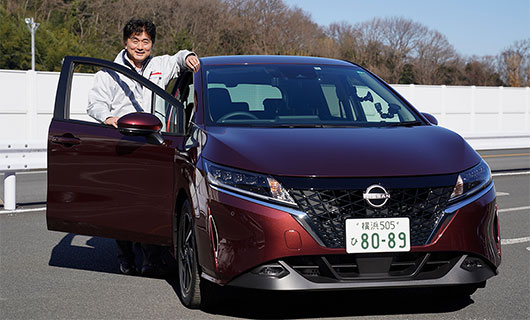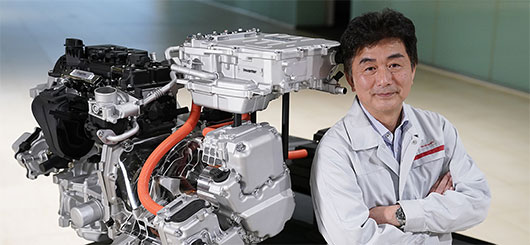
- Citroën C-Zero

- IONIQ Electric
- New Kona Electric
- TUCSON 1.6 T-GDi HEV

- Mercedes-Benz C 350 e
- Mercedes-Benz S-500 Plug-In Hybrid

- OPEL Ampera

- Tesla Model S
- Tesla Model X

- Volkswagen e-Crafter
- Volkswagen e-up!
- Volkswagen e-Golf
- Volkswagen Passat GTE
- Volkswagen Golf GTE
Naoki Nakada - a mérnök, aki a Nissan R35 GT-R vezetési élményét beépítette a Nissan LEAF-be
A Nissan e-POWER technológiája a Nissan R35 GT-R vezetési élményét ötvözi a villanymotor hajtotta jármű azonnali és egyenletes gyorsulásával.

Naoki Nakada - Nissan’s chief powertrain engineer
Naoki Nakada, a Nissan hajtáslánc főmérnöke az autók szerelmese. Ő a "felelős" a márka legsikeresebb motorjainak fejlesztéséért, például a nagyra becsült VR38DETT motorért, amelynek az R35 GT-R az "ülésbe-préselő" erejét és gyorsulását köszönheti. Nakada-t nemcsak a belsőégésű motorok duruzsolása igézte meg, ő fejlesztette a csendes, ugyanakkor dinamikus hajtásláncot a világ első tömegpiacra készült 100%-osan elektromos járművéhez, a LEAF-hez is. Ezek után szinte természetes, hogy a következő projektje a két legjobb hajtáslánc kombinálása volt, a sportautó sebessége és ereje valamint az EV indulási nyomatékának párosítása. Így született meg a Nissan e-POWER technológiája. A nagy teljesítményű autók rajongóinak a Nissan GT-R mindig is legenda volt, köszönhetően sportos kezelhetőségének és kivételes sebességének. - Az R35 GT-R fejlesztésénél nem csupán a sebességre törekedtünk, hanem a kielégítő gyorsulási élményre is - mondja Nakada.
Nakada a Nissan LEAF teljesen elektromos hajtásláncának kifejlesztése után eltökélte, hogy a GT-R-rel szerzett tapasztalatait beépíti az elektromos járművek új generációjába is. - Ha karbonsemleges társadalmat szeretnénk létrehozni, akkor népszerűsítenünk kell az elektromos járműveket. Nem elég, ha egy Nissan elektromos jármű környezetbarát, szükséges, hogy szórakoztató és izgalmas legyen vezetni is - állítja a főmérnök.
A tradicionálisról a teljesen elektromos mobilitásra való átállás azonban nem történik meg egy nap alatt. Sokan hezitálnak az EV tulajdonlás kapcsán a hatótávolság és a töltőinfrastruktúra miatt. Ezt felismerve Nakada arra vállalkozott, hogy enyhíti a vásárlói aggodalmakat és egy olyan elektromos hajtásláncot fejleszt, amely kombinálja a villanymotor izgalmas teljesítményét a tradicionális belsőégésű motorral szerelt jármű használatának könnyedségével. Innen ered a Nissan e-POWER technológia.
A Nissan e-POWER más mint a tipikus hibrid rendszerek, az e-hajtáslánc működését oly módon egyszerűsíti le, hogy a a kerekeket kizárólag a nagy teljesítményű villanymotor hajtja. A villanymotort energiával tápláló lítium-ion akkumulátort egy kiemelkedően hatékony, fedélzeti belsőégésű motor tölti, ami generátorként funkcionál.
Az e-POWER folyamatos és erőteljes gyorsulási élményt nyújt a vezetőnek, ami hasonlít az elektromos autókéhoz, a töltéssel kapcsolatos aggodalom nélkül. Az újratöltéshez csak egy benzinkút meglátogatása szükséges. Ez a technológia az elektromobilitást sokkal több sofőr számára teszi elérhetővé, mint valaha.
A Nissan e-POWER rendszernek az üzemanyaghatékonyság is fontos jellemzője, ugyanis a töltőmotor mindig a töltéshez szükséges optimalizált fordulatszámon működik. A motor elsősorban nagyobb sebességnél vagy egyenetlen utak esetén aktiválódik, amikor a hangját elnyomja a menetzaj. Ez biztosítja, hogy a vezetési élmény csendes legyen, hasonlóan egy villanyautóéhoz városi szituációban.
- Az e-POWER egy könnyen kifejleszthető, egyszerű rendszernek tűnik. Valójában ennek az ellenkezője igaz. Megfelelően egyensúlyba kell hozni az elektromosság használatát és az áramtermelést, meg kell határozni a benzinmotor működésének tökéletes időzítését és az akkumulátor kapacitását az autó típusához kell igazítani. Sok fejlesztési munkát fektettünk a vásárlói élmény tökéletesítésébe - magyarázza Nakada.
A Nissan 2016-ban a japán piacon a Note segítségével indította útjára az e-POWER rendszert, majd ezt rövidesen követte a Serena e-POWER modell. Az e-POWER járművek sikere nem állt meg a növekedésben és a japán értékesítés az 500 000 darabot közelíti. A Note 2018-ban Japán legkelendőbb autója titulust kapta. 2020-ban Japánban és néhány ázsiai piacon megjelent a Kicks e-POWER crossover, ezzel tovább nőtt az e-POWER technológia elterjedése.
Az e-POWER további piacokon történő terjeszkedésével Nakada eltökélten folytatja a kutatás-fejlesztési munkát, célja, hogy a hajtáslánc optimalizálva legyen minden egyes régió vezetési szokásaira és forgalmi helyzeteire.
- Szeretnénk az e-POWER rendszert a lehető legtöbb ember számára elérhetővé tenni, amilyen hamar csak lehet. Az e-POWER-rel teljes elektromos vezetési élményben részesülhetnek a vásárlók, ami segít közelebb kerülni a karbonsemleges, elektromos mobilitású világ eléréséhez. - tette hozzá Nakada.
Meet the engineer who’s bringing GT-R exhilaration to Nissan’s electrified vehicles
Nissan’s e-POWER technology blends the driving feeling of Nissan’s R35 GT-R with the instant, smooth acceleration of an electric motor
Naoki Nakada is definitely a car lover. As one of Nissan’s chief powertrain engineers, he’s been in charge of developing some of the brand’s most iconic engines, including the revered VR38DETT engine which provides the muscle and pin-to-your-seat acceleration of the R35 GT-R. However, it’s not just the roar of combustion engines at wide open throttle that has fascinated Nakada. He also developed the quiet, mild-mannered powertrain for Nissan’s all-electric LEAF, the world’s first mass market 100% electric vehicle. Having worked on both ends of the spectrum, his next project was to combine the best of both powertrains - the speed and power of a sports car and the torque-on-demand nature of an EV – welcoming Nissan’s e-POWER technology.
For fans of high-performance cars, the Nissan GT-R has always had legendary status, thanks to its athletic handling and exceptional speed.
“When we were developing the R35 GT-R, we were not just pursuing speed, but also that satisfying acceleration feeling,” said Nakada “For GT-R drivers, there’s little that compares to the amazing feeling of putting it through its paces.”
After developing the all-electric powertrain for the Nissan LEAF, however, he was determined to bring his GT-R experience to the next generation of electrified vehicles.
“If we want to create a carbon neutral society, we have to promote electric vehicles,” stated Nakada “An electric vehicle from Nissan should not only be environmentally friendly but also be fun and exciting to drive."

Naoki Nakada - Nissan’s chief powertrain engineer
A powertrain that takes the hurdles of e-mobilityThe transition from traditional to fully electric mobility, however, won’t happen overnight. Some have hesitations toward EV ownership, such as driving range on a single charge, local and regional charging infrastructure, and cost. Realizing this, Nakada set out to ease customer concerns by developing an electrified powertrain that combines the thrilling performance of an electric motor with the ease of ownership a traditional internal combustion engine (ICE) vehicle offers. This is the origin of Nissan’s e-POWER technology.
Fuel efficiency built in
Nissan e-POWER is different from typical hybrid systems as it simplifies the e-powertrain operation by having the high output electric motor solely provide power to the wheels. The lithium-ion battery powering the electric motor is recharged by a highly-efficient, on-board combustion engine acting as a power generator. For drivers, e-POWER offers a seamless and powerful acceleration experience similar to an EV, without the concern of a charging station. Instead, a visit to a gas station is all that’s needed to refuel. This makes electric mobility available to many more drivers than ever before.
Nissan e-POWER technology explained
Nissan e-POWER, a new level of control in difficult driving conditions
Fuel efficiency is also at the core of Nissan’s e-POWER system with the engine operating at an optimized speed to recharge the battery. The engine is primarily activated at high cruising speeds or over rough road, when the sound of the engine can be masked by road noise. This ensures the driving experience is quiet like an EV in most driving scenes like a run around town."e-POWER looks like a simple system that’s easy to develop. In fact, it’s quite the opposite,” explains Nakada. “You have to get the balance right between electricity use and power generation, ensure the perfect timing for when the gasoline engine operates, and match the battery capacity to the type of car. A lot of development work went into perfecting the customer experience.”
Introducing e-POWER technology to the world
Nissan launched e-POWER in the Note for the Japan market in 2016 with a Serena e-POWER model following soon after. The success of e-POWER vehicles hasn’t stopped climbing and sales in Japan are now approaching 500,000 units; the Note claimed Japan’s best-selling car of 2018. 2020 saw the introduction of the Kicks e-POWER crossover vehicle in Japan and in some Asian markets, expanding the availability of e-POWER technology.
With e-POWER expanding to other markets, Nakada is determined to continue with his research and development work to ensure the powertrain is optimized for the driving habits and traffic conditions of each region:
“We want to offer e-POWER to as many people as possible, as soon as possible. With e-POWER, we are giving them the full electric driving experience, which can in turn help accelerate toward a carbon neutral, electrified mobility world."
Forrás:Reizer Levente
PR Manager
Grand Automotive Central Europe Kft.
#Nissan #LEEF #R35 GT-R #VR38DETT #Naoki Nakada #e-POWER #EV #Note #Kicks #crossover #Serena #chief powertrain engineer #electrified mobility #carbon neutral






























 /zoldhajtas.hu
/zoldhajtas.hu /villany_autok
/villany_autok  /4x4onlineH
/4x4onlineH

